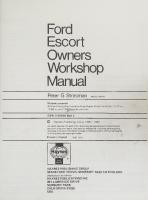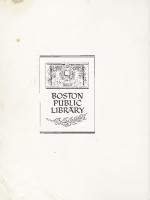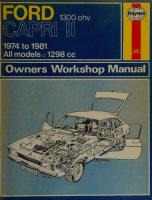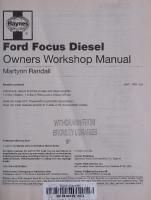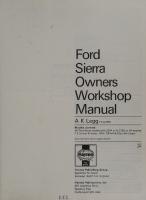Haynes Ford Sierra 2.3 & 2.8 Owners Workshop Manual 1982 to 1987 0856969044, 1850104417, 9781850104414, 9780856969041
Haynes Ford Sierra 2.3 & 2.8 Owners Workshop Manual 1982 to 1987 - A. K. Legg - Haynes Publishing - 1988.
144 121 43MB
English Pages 292 Year 1988
Recommend Papers
File loading please wait...
Citation preview
UT With. .wn
sw
EDINBONEH a.
Cige
LPBRARIES
erence Department q THis BOOK MUST NOT BE REMOVED UNDER ANY PRETEXT FROM THE REFERENCE DEPARTMENT. INFRINGEMENT OF THIS RULE RENDERS THE OFFENDER LIABLE TO PROSECUTION.
Before leaving the Library readers must return the books to one of the attendants at the issue desk, or they will be held responsible for them.
Readers are required to take care of the books. Writing or drawing with pen or pencil on any part of a book, or turning down the leaves, or cutting or mutilating them, will be treated as serious damage. § CONVERSATION IN THE REFERENCE DEPARTMENT IS ANNOYING TO STUDENTS, AND IS NOT PERMITTED. Class
D>
Location.
2
:
C ke/hee
Kfé:
;
Accession.
Ford Sierra Owners Workshop Manual A
K
Legg rend MIMI
Models covered All Ford Sierra models with 2294 cc & 2792 cc V6 engines 2.3 Saloon & Estate, XR4i, XR4x4 & Ghia 4x4 Estate Does not cover Diesel engine models
Haynes Publishing Group Sparkford Nr Yeovil Somerset BA22 7JJ England Haynes Publications, 861 Lawrence Drive Newbury Park California 91320 USA rr
4 ~
=
Inc
|EDINBURGH CITY LIBRARIES
Acknowledgements Thanks are due to the Champion Sparking Plug Company Limited who supplied the illustrations showing the spark plug conditions, and Duckhams Oils who supplied lubrication data. Certain other illustrations are the copyright of Ford Motor Company Limited and are used with their permission. Thanks are also due to Sykes-Pickavant who supplied some of the workshop tools, and all those people at Sparkford who assisted in the production of this Manual.
© Haynes
Publishing
Group 1988
A book in the Haynes Owners
Workshop
Manual
Printed by J. H. Haynes & Co. Ltd, Sparkford, Somerset BA22 7JJ, England
Series
Nr Yeovil,
All rights reserved. No part of this book may be reproduced or transmitted in any form or by any means, electronic or mechanical, including photocopying, recording or by any
information storage or retrieval system, in writing from the copyright holder.
without
permission
ISBN 0 85696 904 4 British Library Cataloguing in Publication Data Legg, A. K. Ford Sierra 2.3 & 2.8 owners workshop manual. — (Owners Workshop Manuals). 1. Automobiles — Maintenance and repair — Amateurs’ manuals I. Title Il. Series
629.28'722 TL152 ISBN 0-85696-904-4 Whilst every care is taken to ensure that the information in this manual is correct, no liability can be accepted by the authors or publishers for loss, damage or injury caused by any
errors in, or omissions from, the information given.
Contents Introductory pages About this manual Introduction to the Ford Sierra V6 General dimensions, weights and capacities Jacking, towing and wheel changing Buying spare parts and vehicle identification numbers General repair procedures Tools and working facilities Conversion factors Safety first! Routine maintenance Recommended lubricants and fluids Fault diagnosis Chapter 1 Engine
26
Chapter 2 Cooling system
53
Chapter 3 Fuel and exhaust systems
60
Chapter 4 Ignition system
76
Chapter 5 Clutch
86
Chapter 6 Manual gearbox and automatic transmission
91
Chapter 7 Propeller shaft
124
Chapter 8 Final drive and driveshafts
128
Chapter 9 Braking system
141
Chapter 10 Suspension and steering
164
Chapter 11 Bodywork and fittings
187
Chapter 12 Electrical system
213
Index
280
Ford Sierra 2.3 Ghia
Ford Sierra XR4i
About
this manual
Its aim The aim of this manual is to help you get the best value vehicle. It can do so in several ways. It can help you decide must be done (even should you choose to get it done by provide information on routine maintenance and servicing,
logical course
of action
and diagnosis when
random
from your what work a garage), and give a
faults occur.
However, it is hoped that you will use the manual by tackling the work yourself. On simpler jobs it may even be quicker than booking the car into a garage and going there twice, to leave and collect it. Perhaps most important, a lot of money can be saved by avoiding the costs a garage must charge to cover its labour and overheads. The manual has drawings and descriptions to show the function of the various components so that their layout can be understood. Then the tasks are described and photographed in a step-by-step sequence so that even a novice can do the work.
[ts arrangement The manual is divided into twelve Chapters, each covering a logical sub-division of the vehicle. The Chapters are each divided into Sections, numbered with single figures, eg 5; and the Sections into paragraphs (or sub-sections), with decimal numbers following on from the Section they are in, eg 5.1, 5.2, 5.3 etc. It is freely illustrated, especially in those parts where there is a detailed sequence of operations to be carried out. There are two forms
Introduction
of illustration: figures and photographs. The figures are numbered in sequence with decimal numbers, according to their position in the Chapter — eg Fig. 6.4 is the fourth drawing/illustration in Chapter 6. Photographs carry the same number (either individually or in related groups) as the Section or sub-section to which they relate. There is an alphabetical index at the back of the manual as well as a contents list at the front. Each Chapter is also preceded by its own individual contents list. References to the ‘left’ or ‘right’ of the vehicle are in the sense of a person in the driver's seat facing forwards. Unless otherwise stated, nuts and bolts are removed by turning anti-clockwise, and tightened by turning clockwise. Vehicle manufacturers continually make changes to specifications and recommendations, and these, when notified, are incorporated into our manuals at the earliest opportunity. Whilst every care is taken to ensure that the information in this manual is correct, no liability can be accepted by the authors or publishers for loss, damage or injury caused by any errors in, or omissions from, the information given.
Project vehicles The vehicles used in the preparation of this manual, and appearing in many of the photographic sequences, included a 1983 model XR4i,
a 1986 model XR4x4 Saloon, and a 1987 model XR4x4 Saloon.
to the Ford Sierra V6
The Ford Sierra was first introduced in late 1982 with the option of seven different engines and four different trim levels. The range has since been considerably expanded and the latest models are equipped with improved instrumentation and trim. This manual covers models fitted with the 2.3 or 2.8 V6 engine and includes the automatic and 4x4 transmission in addition to the standard 4- and 5-speed gearboxes.
For the home mechanic, the Sierra is an ideal car to maintain and repair since design features have been incorporated to reduce the actual cost of ownership to a minimum, with the result that components requiring relatively frequent attention (eg the exhaust system) are easily removed.
ou
SIERRM shee
Ford Sierra Ghia 4x4 Estate
psoy4
e44aIg pX~HX 786L)
(lepowW
General dimensions, weights and capacities Dimensions — mm
(in)
Pre-February 1987
February 1987-on
4407 (173.5) 4505 (177.4)
4425 (174.2) 4511 (177.7)
1920 (75.6) 1920 (75.6)
1694 (66.7) 1694 (66.7)
Overall length (nominal):
SY: |Leo pita cccerati ease eer cent Coa cates oe ESteateee ere tic carcs rec reits se ee ee etre
ce oo ane RP Seer eas ca ornate ake soa Nowa tes SsaseanG
Overall width: ; SAO Os rere teas hence easier ee a eaecscs posh sta Liat eer Tivtas |S EY aad pees Sse ae an cece ee PEE Ce on om ere Overall height (unladen): Saloonn(except XR4igand) KR4AX4)
e005 Se eee. cde escserecesedbcgnecesees doneeess
Saloon (OX RAianGdex Ax) eaccs terres orcs tes orcas temiseerimre ns ieeceae FEST G eeeees eee tee Ee ecen seccans SES eis nccPe sow agtons jeaneveebrsasasnsied
1420 (55.9)
-
1392 (54.8) 1506 (59.3)
13527(53'3) 1386 (54.6)
2608 (102.7) 2611 (102.8)
2608 (102.7) 2611 (102.8)
1453 (57.2) 1468 (57.8) 1458 (57.4)
1453 (57.2) 1468 (57.8) 1458 (57.4)
Wheelbase:
EXCEPt AXA: MOE! Sgeet ccesg cose sare taest ccs ses cccasesatewtigescntstveeses see Samet tosevats AKA GUOCES pean eee etc c cee ces oe cates eG count oc zeta reaceneacins teat ncaa Tar neE AE Track:
FG eeren eae aera aa Oe eRe Tota cs 52 cs ee aeeegnneceurdtaesostevovaatiedttunetatcveacceerees FRE Aiea, SLO OM uersec tena nearer cre arate eo aris arte scaisapteg hee sicies toressaetesTe ieee eaet FREa Mes EStAte eet are erecta aca csc, eran carae ete sasas nates tae eet Bebscsces
Weight — kg (Ib) Kerb weight:
Di SeSal OOM eraceaser en cte rate eee tac eee eee as oaa ee a RRL Ca as ND ae ET ose DB ESt ate cc cee vevacse ta cicatev see oaea tine seat at edster tas nace Seat aN cs cast D8) Sal OOM es ceeaccc acess csr caeancs Toads vs MR eeecas Sas naar Sae rae EES 2:8: EStatees secvcss esureaes acca tates sets te pos a Mea reuse a ON sey oa Maximumiroofgracksloadieie-tas.acscve-ceceoeet attests seine esate te accede suaetines TrailersMOSesWelghitecersse. Sane cece osetia ned Reals. Smee een se aotade ttl
1165 (2568) 1200 (2646) 1270 (2800) 1315 (2900) 75 (165) 25 (55) to 50 (110)
Capacities — litres (pints) Engine oil (drain and refill, including filter):
EXG@ptiA x4! MOGEIS sa csisech ces ccceecaetsd Ee er AXA Ode lSiiceicstrs tetas 15 fhe ea Sore ios oot TRON Glas CEE Soca Loe
4.25 (7.5) 4.65 (8.2)
Cooling system (including heater) .........cccccccscscssescssssscsscssesscscessvesesersees Buel tankolitres (gallons): -..:d:.dess..etecs vessacseestereetnts ate eet ee eae Manual gearbox: aT DQ BDtaeatettres, coeheccs saris ck ees cress a ate ie mAs cyte te eer een a TY PORN (EXCODt AXA) es ceil tite eta Baws eet accuse aie tee ace Eee TyPOH INGA NA) Sete re tesa leas ant vsay houiseeuey RTO cou ots RT nL en TiransSfermbox (4 x4) ces sti ted cave ns enca ee tines ee ee
8.5 (15.0) 60 (13.2)
AUTOMALOMtrAMSIMISSION =2 scrccat eee
6.3 (11.1)
eee cat eee nese
ean
eee
1.46 (2.6) 1.9. (3:3) ids) (222) 0.5 (0.9)
Final drive:
Reaii(excepua xa): ccncce.cecatantinnce Saatie. avevsethotiiis. ae RGare(4x4 etic umcotcenma tetera chins nivel aa ain Gua FEFOMtRCAA)) perccrvact ci vaseainostcracsriies oeeesvsne se vescchecuettva ssucetek eecee e OWOISLOCHING a rare cae eee ae tk
0.9 (1.6) 1.0 (1.8) 0.96 (1.7) 0.75 (1.3)
Jacking, towing and wheel changing Jacking Use the jack supplied with the vehicle only for wheel changing during roadside emergencies (photos). Chock the wheel diagonally opposite the one being removed. _ When raising the vehicle for repair or maintenance, preferably use a trolley or hydraulic jack with a wooden block as an insulator to prevent damage to the underbody. Place the jack under a structural member at the points indicated, never raise the vehicle by jacking up under the engine sump or transmission casing. It is to be preferred and is certainly recommended that the vehicle is positioned over an inspection pit or raised on a lift. When such equipment is not available, use ramps or jack up the vehicle as previously described, but always supplement the lifting device with axle stands.
Towing Towing eyes are provided at both front and rear of the vehicle (photos). The rear towing eye should be used only for emergency towing of another vehicle. Vehicles with automatic transmission must not be towed further than 30 miles (50 km) or faster than 30 mph (50 km/h). If these conditions cannot be met, or if transmission damage has already occurred, the propeller shaft must be removed or the vehicle towed with its rear wheels off the ground. When being towed, disconnect the ignition coil LT leads or the wiring connector at the distributor, and turn the ignition key to position Il. This will unlock the steering and allow the lights and direction indicators to be used. On models with ABS, it will also ensure that the
Remove the cover in the luggage compartment
...
rear brakes operate and the hydraulic system is pressurised. On models with a vacuum servo, additional effort will be required at the footbrake pedal. : Special precautions are necessary when towing 4x4 models without all four wheels on the road. If either the front or rear wheels are suspended, they must be allowed to rotate freely otherwise the transfer box differential gears and viscous couplings will be damaged. If all four wheels are on the road the car may be towed normally.
Wheel changing Park on a firm flat surface if possible. Apply the handbrake and engage first or reverse gear or ‘P’. Chock the wheel diagonally opposite the one being removed. Remove the wheel trim, when applicable, for access to the wheel nuts. Prise the trim off if necessary using the plastic-tipped end of the wheelbrace. Use the other end of the wheelbrace to slacken each wheel nut by half a turn. Jack up the vehicle until the wheel is clear of the ground. Remove the wheel nuts and lift the wheel off the studs. Transfer the wheel centre cap on alloy wheels, then fit the new wheel onto the studs and secure it with the nuts. Tighten the nuts in diagonal sequence until they are snug, but do not tighten them fully yet. Lower the vehicle and remove the jack. Carry out the final tightening of the wheel nuts also in diagonal sequence. The use of a torque wrench is strongly recommended, especially when light alloy wheels are fitted. See Chapter 10 Specifications for the recommended tightening torque. Refit the wheel trim, when applicable, and stow the tools.
. for access to the jack
Spare wheel located in the luggage compartment
Using the wheel brace to remove the wheel cap
The cut-out in the wheel cap location over the tyre valve
Using an axle stand
Front towing eye
Rear towing eye
Location of car jack lifting points (A) and trolley jack lifting points (B)
Buying spare parts and vehicle
identification
numbers
Buying spare parts Spare parts are available from many sources, for example: Ford garages, other garages and accessory shops, and motor factors. Our advice regarding spare parts sources is as follows: Officially appointed Ford garages — This is the best source of parts which are peculiar to your car and are not generally available (eg complete cylinder heads, internal gearbox components, badges, interior trim etc). It is also the only place at which you should buy parts if your vehicle is still under warranty — non-Ford components may invalidate the warranty. To be sure of obtaining the correct parts it will always be necessary to give the storeman your car's vehicle identification number, and if possible, to take the ‘old’ part along for positive identification. Remember that some parts are available on a factory exchange scheme — any parts returned should always be clean! It obviously makes good sense to go straight to the specialists on your car for this type of part for they are best equipped to supply you. Other garages and accessory shops — These are often very good places to buy materials and components needed for the maintenance of your car (eg oil filters, spark plugs, bulbs, drivebelts, oils and greases, touch-up paint, filler paste, etc). They also sell general
accessories, usually have convenient opening hours, charge lower prices and can often be found not far from home. Motor factors — Good factors will stock all of the more important components which wear out relatively quickly (eg clutch components, - pistons, valves, exhaust systems, brake cylinders/pipes/hoses/seals and pads etc). Motor factors will often provide new or reconditioned components on a part exchange basis — this can save a considerable amount of money!
Vehicle identification numbers When ordering spare parts, always give as much information as possible. Quote the car model, year of manufacture, body and engine numbers as appropriate. The vehicle identification number (VIN) plate is mounted on the right-hand side of the body front panel, and may be seen once the bonnet is open (photo). Besides the VIN it also carries information on the vehicle equipment and permissible loads. The engine number is located on the left-hand side of the cylinder block above the fuel pump or blanking plate.
Engine identification
Vehicle identification number
(VIN) plate
Date code
Engine code
C
Engine number
General
repair procedures
Whenever servicing, repair or overhaul work is carried out on the car or its components, it is necessary to observe the following procedures and instructions. This will assist in carrying out the operation efficiently and to a professional standard of workmanship.
Joint mating faces and gaskets Where a gasket is used between the mating faces of two components, ensure that it is renewed on reassembly, and fit it dry unless otherwise stated in the repair procedure. Make sure that the mating faces are clean and dry with all traces of old gasket removed. When cleaning a joint face, use a tool which is not likely to score or damage the face, and remove any burrs or nicks with an oilstone or fine file. Make sure that tapped holes are cleaned with a pipe cleaner, and keep them free of jointing compound if this is being used unless specifically instructed otherwise. Ensure that all orifices, channels or pipes are clear and blow through them, preferably using compressed air.
Oil seals Whenever an oil seal is removed from its working location, either individually or as part of an assembly, it should be renewed. The very fine sealing lip of the seal is easily damaged and will not seal if the surface it contacts is not completely clean and free from scratches, nicks or grooves. If the original sealing surface of the component cannot be restored, the component should be renewed.
Protect the lips of the seal from any surface which may damage them
in the course
of fitting.
Use tape or a conical
sleeve
where
possible. Lubricate the sea! lips with oil before fitting and, on dual lipped seals, fill the space between the lips with grease.
Unless otherwise stated, oil seals must be fitted with their sealing lips toward the lubricant to be sealed. Use a tubular drift or block of wood of the appropriate size to install the seal and, if the seal housing is shouldered, drive the seal down to the shoulder. If the seal housing is unshouldered, the seal should be fitted with its face flush with the housing top face.
Screw threads and fastenings Always ensure that a blind tapped hole is completely free from oil,
grease, water or other fluid before installing the bolt or stud. Failure to do this could cause the housing to crack due to the hydraulic action of the bolt or stud as it is screwed in. When tightening a castellated nut to accept a split pin, tighten the nut to the specified torque, where applicable, and then tighten further to the next split pin hole. Never slacken the nut to align a split pin hole unless stated in the repair procedure. When checking or retightening a nut or bolt to a specified torque setting, slacken the nut or bolt by a quarter of a turn, and then retighten to the specified setting.
Locknuts, locktabs and washers Any fastening which will rotate against a component or housing in the course of tightening should always have a washer between it and the relevant component or housing. ‘Spring or split washers should always be renewed when they are used to lock a critical component such as a big-end bearing retaining nut or bolt. Locktabs which are folded over to retain a nut or bolt should always be renewed. Self-locking nuts can be reused in non-critical areas, providing resistance can be felt when the locking portion passes over the bolt or stud thread. Split pins must always be replaced with new ones of the correct size for the hole.
Special tools Some repair procedures in this manual entail the use of special tools such as a press, two or three-legged pullers, spring compressors etc. Wherever possible, suitable readily available alternatives to the manufacturer's special tools are described, and are shown in use. In some instances, where no alternative is possible, it has been necessary to resort to the use of a manufacturer's tool and this has been done for reasons of safety as well as the efficient completion of the repair operation. Unless you are highly skilled and have a thorough understanding of the procedure described, never attempt to bypass the use of any special tool when the procedure described specifies its use. Not only is there a very great risk of personal injury, but expensive damage could be caused to the components involved.
Tools and working facilities Introduction A selection of good tools is a fundamental requirement for anyone
contemplating the maintenance and repair of a motor vehicle. For the owner who does not possess any, their purchase will prove a considerable expense, offsetting some of the savings made by doing-it-yourself. However, provided that the tools purchased meet the relevant national safety standards and are of good quality, they will last for many years and prove an extremely worthwhile investment. To help the average owner to decide which tools are needed to carry out the various tasks detailed in this manual, we have compiled three lists of tools under the following headings: Maintenance and minor repair, Repair and overhaul, and Special. The newcomer to practical mechanics should start off with the Maintenance and minor repair tool kit and confine himself to the simpler jobs around the vehicle. Then, as his confidence and experience grow, he can undertake more difficult tasks, buying extra tools as, and when, they are needed. In this way, a Maintenance and minor repair tool kit can be built-up into a Repair and overhaul tool kit over a considerable period of time without any major cash outlays. The experienced do-it-yourselfer will have a tool kit good enough for most repair and overhaul procedures and will add tools from the Specia/ category when he feels the expense is justified by the amount of use to which these tools will be put. It is obviously not possible to cover the subject of tools fully here. For those who wish to learn more about tools and their use there is a book entitled How to Choose and Use Car Tools available from the publishers of this manual.
Maintenance and minor repair tool kit The tools given in this list should be considered as a minimum requirement if routine maintenance, servicing and minor repair operations are to be undertaken. We recommend the purchase of combination spanners (ring one end, open-ended the other); although more expensive than open-ended ones, they do give the advantages of both types of spanner.
Combination spanners - 10, 17, 12, 13, 14 & 17 mm Adjustable spanner - 9 inch Engine sump/gearbox/rear axle drain plug key Spark plug spanner (with rubber insert) Spark plug gap adjustment toc/ Set of feeler gauges Brake adjuster spanner Brake bleed nipple spanner Screwdriver - 4 in long x 1/4 in dia (flat blade) Screwdriver - 4 in long x '/4 in dia (cross blade) Combination pliers - 6 inch Hacksaw (junior) Tyre pump Tyre pressure gauge
Grease gun Oil can Fine emery cloth (1 sheet) Wire brush (smal!) Funnel (medium size)
Repair and overhaul tool kit These tools are virtually essential for anyone undertaking any major repairs to a motor vehicle, and are additional to those given in the Maintenance and minor repair list. \Included in this list is a comprehensive set of sockets. Although these are expensive they will be found invaluable as they are so versatile - particularly if various drives are included in the set. We recommend the % in square-drive type, as this can be used with most proprietary torque wrenches. If you cannot afford a socket set, even bought piecemeal, then inexpensive tubular box spanners are a useful alternative.
The tools in this list will occasionally need to be supplemented tools from the Speci/a/ list.
by
Sockets (or box spanners) to cover range in previous list Reversible ratchet drive (for use with sockets) Extension piece, 10 inch (for use with sockets) Universal joint (for use with sockets) Torque wrench (for use with sockets) ‘Mole’ wrench - 8 inch Ball pein hammer Soft-faced hammer, plastic or rubber Screwdriver - 6 in long x 5/16 in dia (flat blade) Screwdriver - 2 in long x 5/16 in square (flat blade)
Screwdriver - 11/2 in long x '/4 in dia (cross blade) Screwdriver - 3 in long x '/8 in dia (electricians) Pliers - electricians side cutters Pliers - needle nosed Pliers - circlip (internal and external)
Cold chisel - 1/2 inch Scriber Scraper Centre punch Pin punch Hacksaw
Valve grinding tool Stee/ rule/straight-edge Allen keys (inc. splined/Torx type if necessary) Selection of files Wire brush (large) Axle-stands Jack (strong trolley or hydraulic type)
Special tools The tools in this list are those which are not used regularly, are expensive to buy, or which need to be used in accordance with their manufacturers’ instructions. Unless relatively difficult mechanical jobs are undertaken frequently, it will not be economic to buy many of these tools. Where this is the case, you could consider clubbing together with friends (or joining a motorists’ club) to make a joint purchase, or borrowing the tools against a deposit from a local garage or tool hire specialist. The following list contains only those tools and instruments freely
14
Tools and working facilities
SS
available to the public, and not those special tools produced by the vehicle manufacturer specifically for its dealer network. You will find occasional references to these manufacturers’ special tools in the text of this manual. Generally, an alternative method of doing the job without the vehicle manufacturers’ special tool is given. However, . sometimes, there is no alternative to using them. Where this is the case and the relevant tool cannot be bought or borrowed, you will have to entrust the work to a franchised garage.
Spanner jaw gap comparison table Jaw gap (in)
Spanner size
0.250
1/4 in AF
0.276
7 mm
0.313
5/16 in AF
0.315
8mm
0.344
11/32 in AF; 4/8 in Whitworth
0.354 0.375 0:394 0.433 0.438
9mm 3/3 in AF 10 mm 11 mm 7146 in AF
0.445
3/16 in Whitworth; 1/4 in BSF
0.472 0.500 0.512
12 mm 1/2 in AF 13 mm
0.525
1/4 in Whitworth; 5/16 in BSF
0.551 0.563 0.591
14 mm 9/16 in AF 15 mm
Buying tools
0.600 0.625
5/16 in Whitworth; 3/8 in BSF 5/8 in AF
For practically all tools, a tool factor is the best source since he will have a very comprehensive range compared with the average garage or accessory shop. Having said that, accessory shops often offer excellent quality tools at discount prices, so it pays to shop around. There are plenty of good tools around at reasonable prices, but always aim to purchase items which meet the relevant national safety standards. If in doubt, ask the proprietor or manager of the shop for advice before making a purchase.
0.630 0.669 0.686 0.709 0.710 0.748 0.750 0.813
16 mm 17 mm 11/46 in AF 18 mm 3/3 in Whitworth; 7/16 in BSF 19 mm i 3/4 in AF 13/46 in AF
0.820
7/16 in Whitworth; 1/2 in BSF
Care and maintenance of tools
0.866 0.875
22 mm 7/3 in AF
0.920 0.938
1/2 in Whitworth; 9/16 in BSF 15/16 in AF
0.945 1.000 1.010 1.024
24 mm 1 in AF 9/16 in Whitworth; 26 mm
1.063 1.100
11/16 in AF; 27 mm 5/3 in Whitworth; 11/16 in BSF
e225 1.181 1.200 1.250 1.260 1.300 esis
11/8 in AF 30 mm 11/16 in Whitworth; 3/4 in BSF 11/4 in AF 32 mm 3/4 in Whitworth; 7/8 in BSF 15/16in AF
1.390
13/46 in Whitworth; 15/16 in BSF
1.417 1.438 1.480 1.500
36 mm 17/16 in AF 7/8 in Whitworth; 11/2 in AF
1.575
40 mm; 19/16 in Whitworth
1.614 1.625 1.670 1.688 1.811 1.813 1.860 1.875 1.969 2.000
41 mm 15/8 in AF 1 in Whitworth; 11/8 in BSF 111/16in AF 46 mm 113/46in AF 11/3 in Whitworth; 11/4 in BSF 17/8 in AF 50 mm 2 in AF
Valve spring compressor (where applicable) Piston ring compressor Balljoint separator Universal hub/bearing puller
Impact screwdriver Micrometer and/or vernier gauge Dial gauge Stroboscopic timing light Dwell angle meter/tachometer Universal electrical multi-meter Cylinder compression gauge Lifting tackle Trolley jack Light with extension lead
Having purchased a reasonable tool kit, it is necessary to keep the tools in a clean serviceable condition. After use, always wipe off any dirt, grease and metal particles using a clean, dry cloth, before putting the tools away. Never leave them lying around after they have been used. A simple tool rack on the garage or workshop wall, for items such as screwdrivers and pliers is a good idea. Store all normal wrenches and sockets in a metal box. Any measuring instruments, gauges, meters, etc, must be carefully stored where they cannot be damaged or become rusty. Take a little care when tools are used. Hammer heads inevitably become marked and screwdrivers lose the keen edge on their blades from time to time. A little timely attention with emery cloth or a file will soon restore items like this to a good serviceable finish.
Working facilities Not to be forgotten when discussing tools, is the workshop itself. If anything more than routine maintenance is to be carried out, some form of suitable working area becomes essential. It is appreciated that many an owner mechanic is forced by circumstances to remove an engine or similar item, without the benefit of a garage or workshop. Having done this, any repairs should always be done under the cover of a roof. Wherever possible, any dismantling should be done on a clean, flat workbench or table at a suitable working height. Any workbench needs a vice: one with a jaw opening of 4 in (100 mm) is suitable for most jobs. As mentioned previously, some clean dry storage space is also required for tools, as well as for lubricants, cleaning fluids, touch-up paints and so on, which become necessary. Another item which may be required, and which has a much more
general usage, is an electric drill with a chuck capacity of at least 5/16 in (8 mm). This, together with a good range of twist drills, is virtually essential for fitting accessories such as mirrors and reversing lights. Last, but not least, always keep a supply of old newspapers and clean, lint-free rags available, and try to keep any working area as clean as possible.
E
5/8 in BSF
1 in BSF
2.050
11/4 in Whitworth; 13/8 in BSF
2ANGS 2.362
55 mm 60 mm
Conversion factors Length (distance) Inches (in) Feet (ft) Miles
25.4 0.305 1.609
x


